- The Russian Sukhoi Su-57, a fifth-generation stealth fighter jet, performed a notable aerial display at Aero India, generating significant interest.
- The event took place at the Indian Air Force Station in Yelahanka, showcasing the Su-57 alongside the American F-35.
- Russia offers the Su-57 to India as a means to revitalize its aging air force amidst regional tensions.
- The jet features advanced stealth capabilities and cutting-edge technology, promising significant advantages.
- Concerns persist about the Su-57’s reliability, given a past crash in 2019 and ongoing issues in the Russian defense sector.
- India’s decision on acquiring the Su-57 could significantly impact its defense strategy and Russia’s role in aerial technology.
As the sun warmed the tarmac at Aero India, all eyes fixated on a spectacular airborne ballet performed by a Russian Sukhoi Su-57, a fifth-generation stealth fighter jet that seemed to defy gravity. With clouds as its stage, the jet pirouetted with the grace of a five-ton ballerina at 600 meters, showcasing capabilities that could potentially alter the landscape of Indian defense.
The event unfolded at the Indian Air Force Station in Yelahanka, where the advanced warplane shared airspace with its American counterpart, the F-35. Against a backdrop of tension and competition, Russia unfurled its most advanced piece of military craftsmanship, offering it to India, a trusted ally, to rejuvenate its aging air force.
Draped in a “pixelated” camouflage of dark and light hues, the Su-57 promises more than just good looks. Boasting stealth capabilities and armed with cutting-edge technology, it offers an enticing proposition to a nation anxious to bolster its defenses amid regional tensions.
Whispers of the fighter jet’s agility dance like a siren song, enticing India to consider its potential advantages over the F-35. Yet, doubts linger like shadows. A crash in 2019 and ongoing skepticism about its reliability cast a murky light on the proposal, echoing the challenges that Russia faces as it navigates sanctions and a beleaguered defense industry.
In a world where innovation and strategy tame the sky, India’s decision could be a watershed moment—and Russia’s offering could either ignite a new chapter in aerial dominance or falter under the weight of its own ambitions. The Su-57, suspended in both air and expectation, watches to see if this dance will find its partner.
The High-Stakes Duel Between the Su-57 and F-35: A Battle of the Skies
Introduction
While the international stage spotlighted the Su-57 and its exhilarating performance at Aero India, significant details remain outside the bounds of common coverage. This exploration unveils essential insights about the Russian Sukhoi Su-57 and its position in a competitive market, elevating the conversation beyond the airshow’s dazzling display.
Features and Specifications of the Su-57
The Su-57, Russia’s fifth-generation multirole fighter, is outfitted with state-of-the-art avionics, enhanced stealth technology intended to provide invisibility to radar, and innovative weaponry. It features the N036 active electronically scanned array radar, capable of tracking multiple air and ground targets simultaneously.
With a supercruise capability, the Su-57 can maintain supersonic speeds without afterburners, reducing fuel consumption and heat signature. The aircraft integrates thrust vectoring nozzles, granting superior maneuverability—a crucial advantage in dogfight scenarios.
Innovations and Security Aspects
The Su-57’s design emphasizes reducing radar cross-section (RCS), employing composite materials for a lower profile. This enhances stealth capabilities, vital for strategic missions behind enemy lines. Nevertheless, the crash in 2019 raised concerns over production quality and reliability, which have become crucial hurdles as Russia strives to alleviate skepticism.
Comparisons: Su-57 vs. F-35
When comparing the Su-57 with the American F-35, several differences are evident:
– Technology and Stealth: The F-35 boasts a more advanced stealth profile and sensor fusion, operating as an intelligence-gathering node. In contrast, the Su-57 focuses more on sheer agility and kinetic performance.
– Operational Experience: The F-35 has been deployed in various theatres and has accumulated considerable operational data, while the Su-57 is still in its early deployment and testing phases.
– Cost Considerations: The Su-57 is generally perceived to be less expensive than the F-35, potentially making it an attractive option for countries seeking cost-effective solutions.
Market Analysis and Forecasts
Russia continues to market the Su-57 globally despite economic sanctions impacting its defense industry. Potential buyers include countries looking to diversify their military partnerships and those restricted from Western technology. The aircraft’s presence in the international market will depend significantly on Russia’s ability to overcome production issues and deliver on its promises of performance and cost-effectiveness.
Reviews and Criticism
Expert reviews often highlight the Su-57’s impressive design and capabilities. However, criticisms focus on its delayed development schedule and logistical hurdles. The question of adequate after-sales support and integration into existing air forces remains critical for potential buyers.
Predictions and the Future
As geopolitical dynamics shift, the Su-57’s role in regional defense strategies will evolve. India’s decision could influence other nations’ procurement strategies, potentially creating a ripple effect across defense markets.
Related Questions and Answers
Will the Su-57 gain a strong foothold in international markets?
It depends on Russia’s success in overcoming production challenges and convincing international buyers of the aircraft’s reliability and value.
What impact could India’s decision have on global defense alignments?
India’s choices could redefine alliances and influence regional power balances, affecting procurement strategies of neighboring countries.
How does the Su-57 contribute to Russia’s strategic military goals?
The Su-57 enhances Russia’s air superiority and serves as a deterrence tool, reinforcing its global military presence.
Key Resources for Further Exploration
– Lockheed Martin
– Sukhoi
– Indian Defense News
In the ongoing saga of aerial dominance, the stakes are high, and each player’s move is a calculation of power, technology, and strategy. The Su-57, poised to ascend from its challenges, remains a pivotal part of this narrative.







